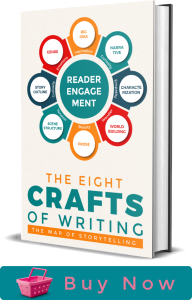Everybody should plant a tree, have a child, and write a book. All these live on after us, ensuring a measure of immortality.
— Attributed to the Talmud and Jose Martí, Cuban revolutionary and poet
The majority of people believe that they have a book in them. We believe that too. We all can look back on unique experiences and expertise, and we all have valuable views on life and wisdom worth sharing.
To become a professional writer takes ten years or more. But to write that one book, you don’t need to become a professional writer. You just need to become a decent writer and the unique story that only you can tell will do the rest.
But you still need to learn the ropes and that can take four to five years. The Eight Crafts of Writing can help you cut that time in half because it gives you a structured overview of storytelling.
Create an interesting character and give her a great goal. Create a sense of wonder. The more conflict, the better. Write with intention. Focus on characters’ struggles for objects of desire. Grab the reader. Be captivating. Or memorable. Or originally. Create authenticity. Keep the reader turning pages. Be unpredictable. You can find a ton of writing advice like this on the Internet. By themselves, they sound inspiring. As a bunch, they confuse. Which one to prioritize? Which one to heed when? Which one to ignore when?
Learning how to write feels like parachuting into a jungle. We can only see a few meters into the tangled thicket that teems with cunning predators, poisonous plants, yucky leeches, and sucky swamps. In short, we can’t see the art for tools. This is where Eight Crafts of Writing comes in. It gives you a structured overview of the writing wilderness: the map of storytelling.
Who Should Read the Book or Take the Course?
→ Aspiring writers
→ Writers who are a couple of years into their writing journey but got lost in the weeds (as it happened to the author)
→ Writers interested in the psychology of storytelling and the secrets of story engagement
→ Writers who want to refresh their take on storytelling
What you will learn if you take The course or read the book:
→ The eight writing crafts: Big Idea, Genre, Narrative, Story Outline, Characterization, World Building, Scene Structure, and Prose
→ How to engage readers with the eight crafts
→ A fresh definition of story that keeps your writing focused
→ How to use the psychology of storytelling to write immersive stories
→ The adversity cycle and how to give your story outline a realistic feel
→ How to differentiate between protagonistic and antagonistic genres, story outlines, and scenes and why that matters
→ A new way of dealing with the shapeshifting writer’s block
Take the online course at the Lawson Writer Academy or read the book:
Look inside ↓
Watch how Craig Tuch, Roland Hulme, and Stefan Emunds discuss the eight writing crafts, how to engage readers on multiple levels, the difference between emotions and feelings, and how to revive a dead book.

[…] The idea of showing enlightenment tempted me to venture into fiction writing, and I became a Visionary Fiction author. And I did what all other aspiring writers did: I parachuted straight into the writing jungle. And, like everybody else, I got lost. Five years into my writing adventure, I had learned a lot, but still felt lost. Like lost in the mountains. Learning fiction writing felt like scrambling up a mountain (a craft or skill) just to discover a new one. I needed a reorientation. I looked for an overview of the writing craft, a map, but couldn’t find one and so, I created a map myself. When I was done, I realized other writers may look for a storytelling map too. That prompted me to turn my map into a book on writing: The Eight Crafts of Writing. […]
[…] details in The Eight Crafts of Writing and topics like antagonistic and protagonistic scenes, scene building blocks, the stimulus-response […]